Not many summer residents know at what depth to plant garlic in the winter. Before planting garlic, prepare the soil, take into account the favorable time, and choose the right method. A huge role is played by planting material. Experienced gardeners choose certain varieties of garlic and carry out preparatory measures over the heads of a spicy vegetable.
Content
- 1 The main differences between spring and winter garlic
- 2 Precursor crops: after which plants are planted garlic
- 3 Winter Garlic: Planting Rules
- 4 Determine the planting depth for a spicy vegetable
- 5 What time to plant
- 6 Which grade to prefer
- 7 Soil preparation
- 8 Preparing planting material
- 9 Landing to a depth of 3-5 cm
- 10 Landing to a depth of 10-15 cm
- 11 Best ways to plant garlic in the winter
The main differences between spring and winter garlic
The head of the spring type of garlic has 25 small cloves. Their location goes in 2-3 rows. Missing axial shaft. It tastes softer than winter. It is well stored, and can lie for a year without losing its properties and qualities. Plant spring garlic costs no earlier than spring.
The time for planting a winter variety of garlic is autumn. The head consists of one row of 12 cloves located around a round shaft. The taste is sharp, pungent and intense. Winter varieties are stored for long. They are eaten in autumn and summer, used for canning.
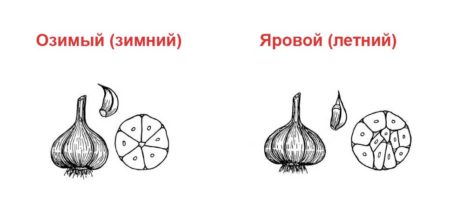
Precursor crops: after which plants are planted garlic
Crop rotation is an important rule for obtaining a high yield on the site. Therefore, it is undesirable to sow the soil with the same crop for more than 2 consecutive years.
Planting garlic will pass favorably after growing:
- cucumbers
- Pumpkins
- squash;
- zucchini;
- melons;
- bell pepper;
- eggplant.
All of these cultures are annuals. They quickly develop and grow, saturating the soil with nitrogen, which garlic needs at one time for proper formation.
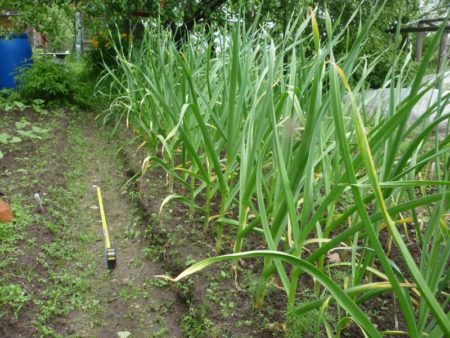
There are vegetables, after which it is undesirable to plant garlic in the fall. They deplete the soil, taking from it the whole complex of useful substances. These include:
- carrot;
- beet;
- potatoes;
- turnip;
- potatoes;
- radish.
Winter Garlic: Planting Rules
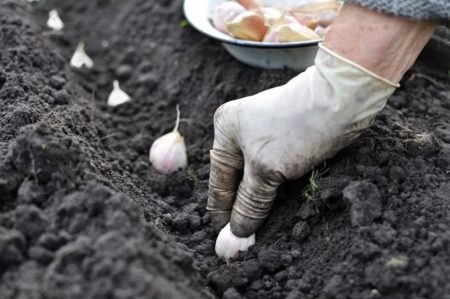
Before planting, organic fertilizers are introduced into the soil. Cow dung will do. However, it can be used in combination with lime treatment or the additional introduction of dolomite flour. Every 3 year change the location of cultivation of winter varieties of garlic. The further algorithm of actions is as follows:
- Only healthy slices are suitable for planting. Before planting, they are treated with potassium permanganate or vitriol.
- The gardener must be careful when sowing. Damage to the teeth should not be allowed. The deepening is not deep, otherwise the root system of the vegetable is poorly formed, and the feathers will germinate for a long time.
- Correctly mark the rows.
- The method of sowing is chosen taking into account the variety of the variety (medium, large or small segments).
Determine the planting depth for a spicy vegetable
The main principle is the words: the deeper you plant the garlic, the higher the likelihood that it will survive the frosts and shoots. Do not overdo it either. It is necessary to sow so that in the spring due to the high level of groundwater it does not rot. If the clove could not overcome the thick soil layer, then it simply will not germinate. For a successful harvest, the plant needs to release the roots.
Since you need to have time to plant garlic material a month before stable frosts, there is another rule: the seeding depth depends on the local agricultural climate. How early the soil freezes. In the cold Siberian land earlier than in other regions of Russia. The root system in such weather will not develop on the surface.
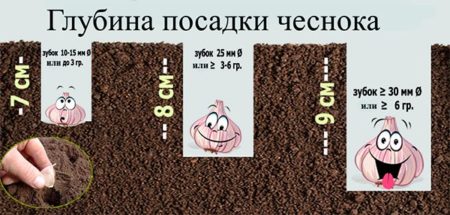
In Siberian regions, the depth of planting of winter garlic is 10-15 cm in the ground. In frosty and snowy winters, the beds should be insulated. This can be done with dry grass. In the warm southern climate (Kalmykia, Krasnodar Territory, Crimea, Sevastopol), the depth of planting of garlic in the winter is 4-5 cm. In Astrakhan, Volgograd, Rostov region this is the same indicator. In the middle zone of the country (Moscow, Vladimir, Ryazan, Tula, Kaluga, Nizhny Novgorod regions, Volga region) 5-10 cm.
What time to plant
The optimal time for planting winter garlic is considered to be the end of September and the beginning of October. The exact date depends on the region, but the most important thing is to drop the wedges about 40 days before the first frost. Then the garlic will have time to take root, grow the root system sufficient for wintering and will not give green shoots until spring. You can also use the lunar calendar according to which there are more accurate dates, it is from September 26-30 to October 1-12.
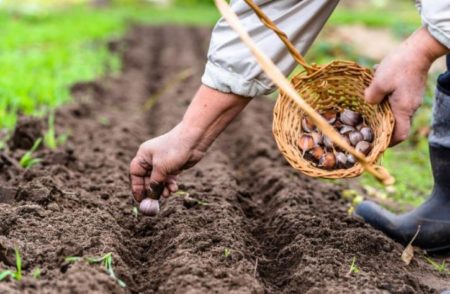
Which grade to prefer
A variety is selected for the autumn planting of garlic, taking into account the climatic characteristics of the region. Preference is given to varieties of winter species of varieties. It has a high yield when planting in open ground. If you plant garlic in the spring, then the output may result in a head with 1-2 teeth.
Zoned varieties for the middle latitudes of Russia:
- Lyubasha
- Union;
- Moscow Region;
- Gribovsky Jubilee;
- Novosibirsk;
- Winter Komsomolets;
- Cramp.
When choosing planting material, pay attention to whether the arrows shoot vegetables during growth or grow without them. Shooting species are large lobules located around an axial ring. The head has 4-12 teeth. If in the head of the teeth in the amount of 14-25 pieces and they are arranged in a spiral, then such garlic, feathers, most likely will not release.
Shooting varieties are not afraid of frost, and essential oils are present in their composition. At the tips of the arrows you can see the inflorescence with seeds (bulbs), they are often used for planting. Such garlic feathers are fragrant and have an interesting flavor, so culinary experts often add them to various dishes.
In areas located in the latitudes of the Russian Federation, it is better to choose domestic varieties. Overseas are more whimsical and require special care, afraid of the cold. It is difficult for them to adapt, and in the suburbs such planting material 2/3 dies.
Soil preparation
Of great importance is the chemical composition of the earth. The best soil for planting a vegetable is sandy soil with normal acidity, which can be created. To do this, you need a bucket of horse manure, 15 g nitrophosk, 10 g superphosphate and a glass of dolomite flour. Fertilizers are poured onto plowed or dug up soil, evenly distributed with a rake. Two weeks later, get to work.
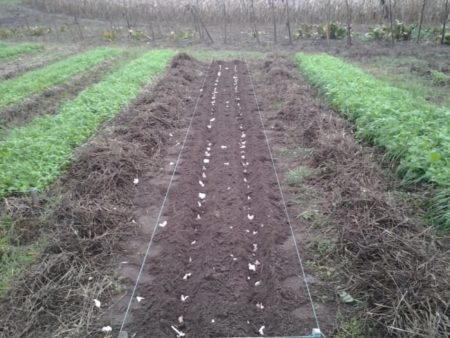
Dig the beds, and fertilize 2 weeks before planting the garlic. Compost is applied per 1 m2 and 1 bucket is used. Then, form a bed (height 20-25 cm). Next, markup is carried out using pegs and twine. They delimit the site, for planting them at the edges. To form the pits, it is better to use a scapular shank or a thin metal tube. Between the rows sprinkled with ash. It will additionally delimit the beds and save the seedlings from pests.
Preparing planting material
There are requirements not only for the soil in which they are sown, but also for the planting material itself. They are very simple:
- Only healthy teeth are used, without damage.
- Before planting a vegetable, make sure that it is properly stored (in a dry room that is ventilated on time). A summer veranda or a canopy is well suited.
- Seedlings taken from the agro-climatic zone, where they plan to plant them.
- The largest are taken for planting, because they will grow larger.
Garlic is the most unpretentious plant in the garden. But it’s better for him to work hard and get an abundant harvest as a reward. This will be possible provided that the bed is fertilized on time, loosened, regularly weeded and irrigated.
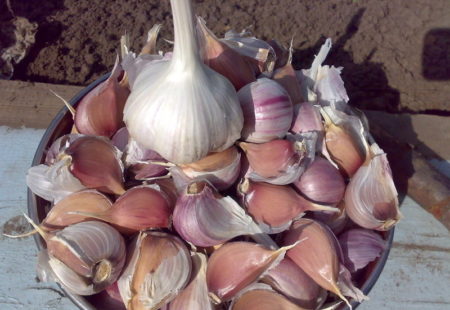
They must be weeded immediately as the first sprouts appeared. The vegetable is most vulnerable at this time: weeds deprive it of moisture and minerals. Then you can periodically loosen without starting more weeding. This is necessary, since this culture grows better on loose soil.
You need to water the garlic all the time, not counting the last month before harvesting. To do this, carefully use a watering can or hose with a shower head. As necessary, make sure that the earth does not dry out and is not swampy.
Landing to a depth of 3-5 cm
At a depth of 3-5 cm, garlic is sown long before the first frosts (40 days). Specific dates depend on local climate. In central Russia, this is the end of September, the beginning of October. In Siberia - since the beginning of autumn. The population of the southern strip lands in November.
The spaces between the cloves leave 10-15 cm. The width between the grooves is 15-20, but if the planting material is small, the distance between the rows is less than 8-12 cm. If you plant garlic seeds, leave 5 cm between them, and between the rows leave 9-10 cm of space.

The bed is prepared in advance, 3 weeks before the start of work. During this time, the earth will settle. They make a height of at least 20 centimeters. Stages of work:
- Dig up the earth, add humus or compost (in a bucket per square meter of area).
- You can make 1 tbsp. spoon of superphosphate and nitrophosphate.
- Rake fertilizer mixed with soil. It remains only to beautifully form the appearance. To do this, use a canvas shovel. The ridge is ready.
Landing to a depth of 10-15 cm
At a depth of 10-15 cm, garlic is planted in a cold climate so that it can overwinter. There is another reason when the weather changes dramatically, and frosts are expected earlier.
Work sequence:
- preparation of soil for planting (digging or plowing, fertilizing);
- the formation of a bed 3-4 weeks before the start of work, so that it has time to settle, then the cloves will not go deeper than expected, and will sprout well;
- before planting, planting material is placed in size from smaller to larger;
- water the bed;
- prepare the markup.
Large cloves plant at a distance of 15 cm, and small enough 8 cm.
By drawing the lines for marking the rows we get at a distance of 20 cm. Before this, the soil is irrigated with water - so the fertilizer is activated.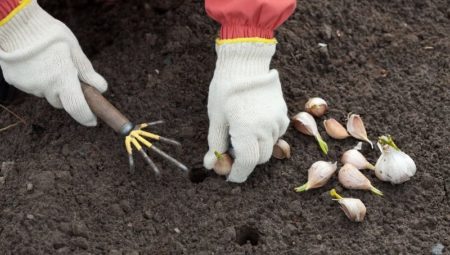
Best ways to plant garlic in the winter
Despite the continuous improvement of methods for cultivating garlic, there are few of them that are used more often. Here are just three.
Method 1. Sowing. Seeds or garlic cloves are sown in previously prepared furrows. The bed before this is watered. It yields a lot, but the stalk is not always smooth, because the cloves are laid to one side.
Method 2Two tiers. It is good to use for small plots of land, or if there is a need for a large number of crops. This is achieved thanks to two tiers of landing, from which the name comes. The depth of seedlings of the lower floor is 10-12 cm, and the upper one is 5-6 cm from the soil surface. The lower tier with planted seeds is dug up with earth, then the upper one is laid.
Method 3. Classic. The gaps between the rows make 20 cm. The seed is planted on dry ground, covered with fallen leaves. It is favorable if gourds were sown here before garlic. In the chosen place there should not be melt water in the spring. After planting, mulch the earth with dry leaves.

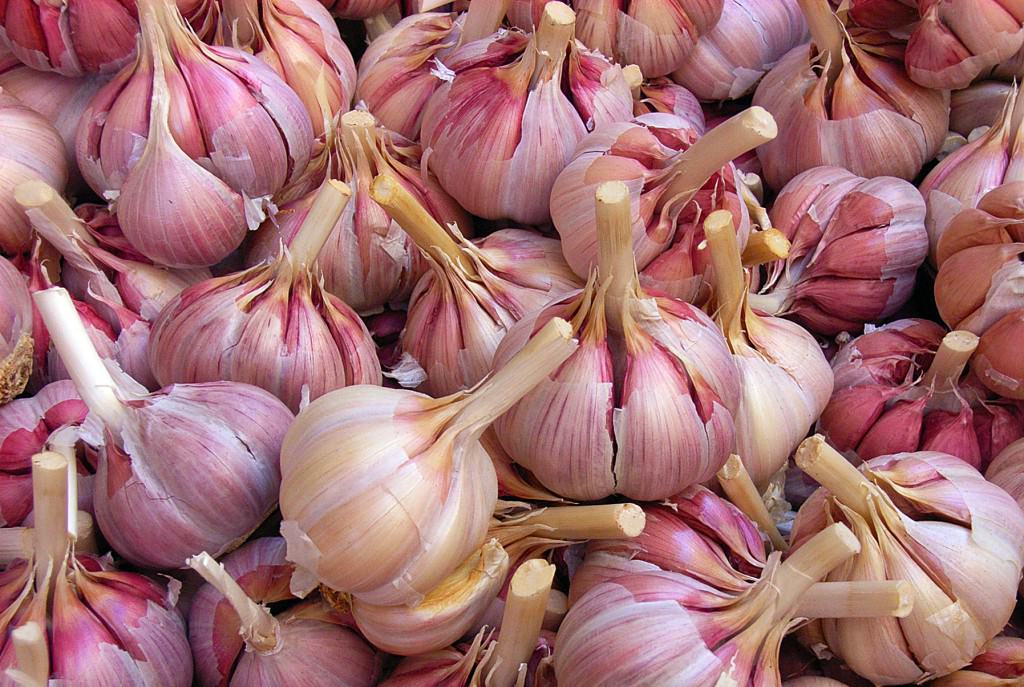
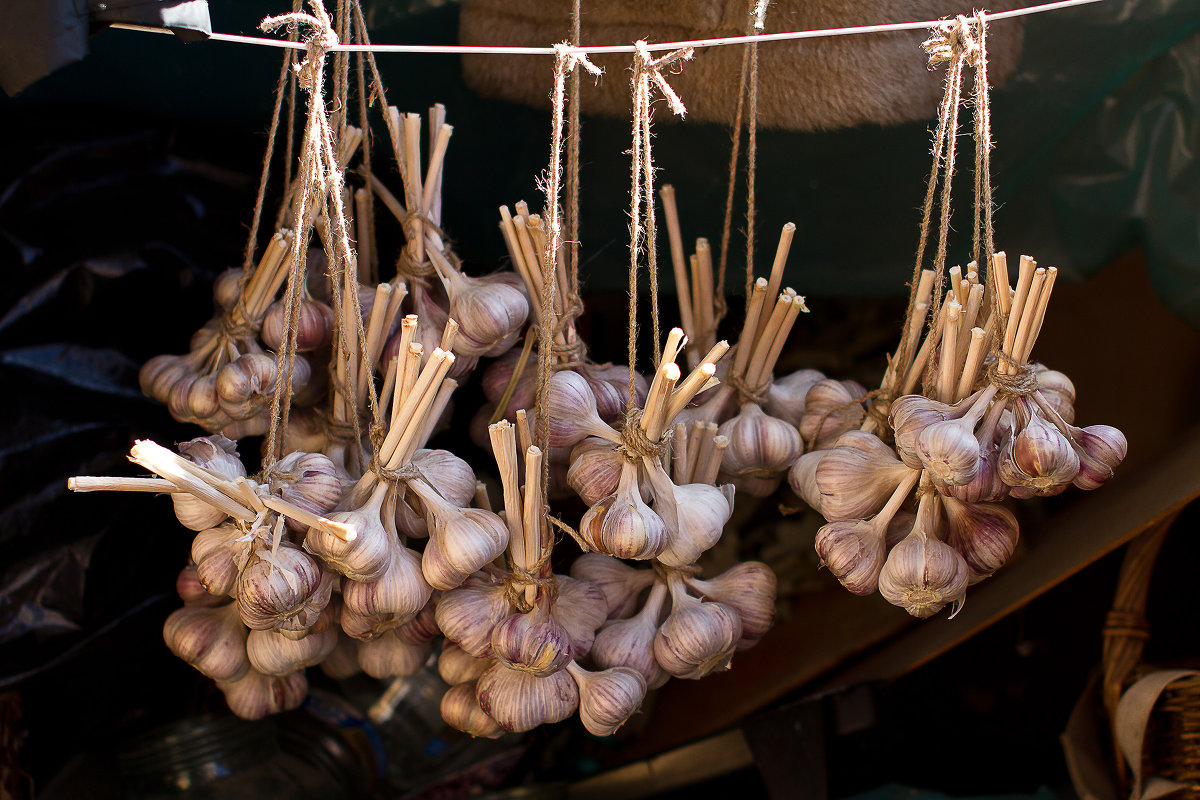 Methods for storing garlic in the winter at home
Methods for storing garlic in the winter at home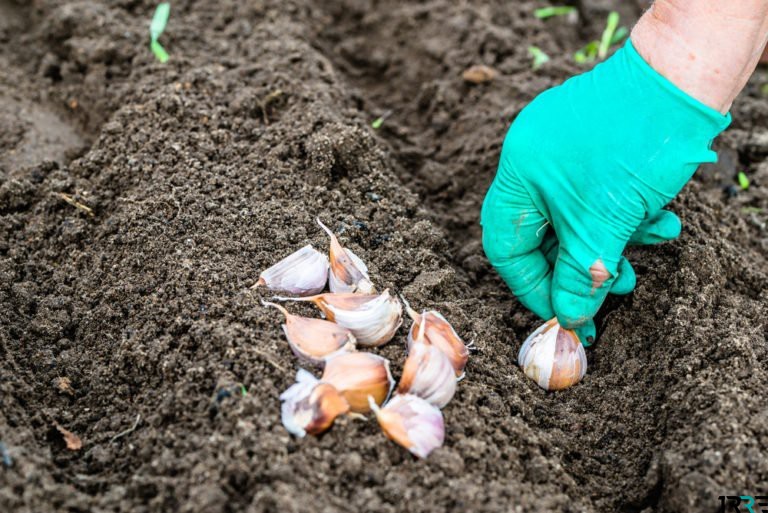 Processing garlic before planting in the winter: soaking garlic and tillage
Processing garlic before planting in the winter: soaking garlic and tillage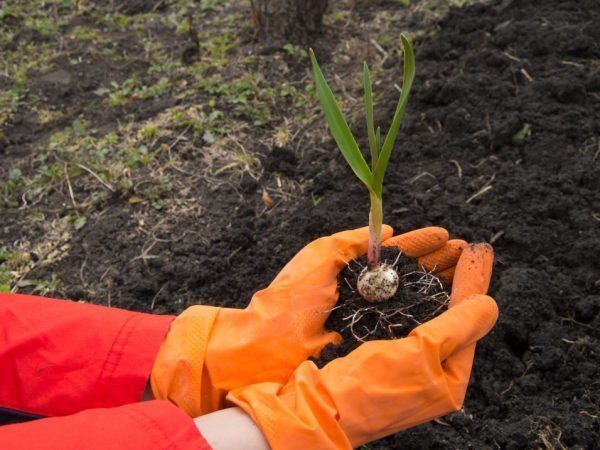 Fertilizers when planting garlic in the fall: how to fertilize the soil
Fertilizers when planting garlic in the fall: how to fertilize the soil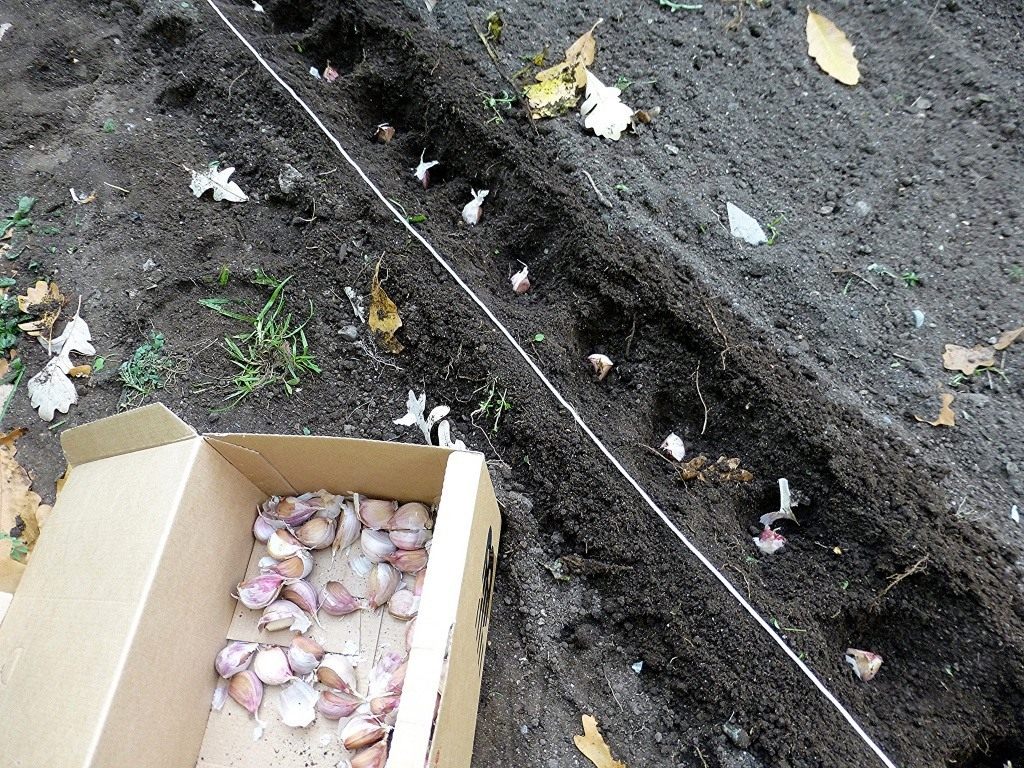 Features planting garlic in the winter in the fall
Features planting garlic in the winter in the fall